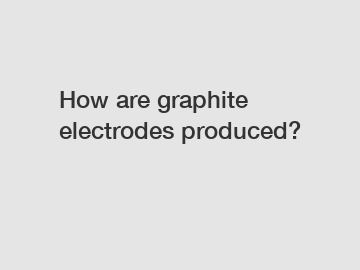Dec. 27, 2023
Minerals
How Are Graphite Electrodes Produced?
Graphite electrodes are essential components widely used in various industries such as steelmaking, metallurgy, and nuclear energy. They play a critical role in conducting electricity and are often subjected to extreme temperatures and corrosive conditions. But have you ever wondered how these graphite electrodes are produced? In this article, we will explore the fascinating process of manufacturing graphite electrodes.
Raw Materials and Preparation.

The production of graphite electrodes starts with the selection and preparation of raw materials. High-quality petroleum coke, which is a solid carbon material derived from oil refinery processes, is the primary ingredient used for graphite electrode production. Petroleum coke is chosen for its high carbon content, low impurity levels, and excellent electrical conductivity.
To ensure that the petroleum coke meets the desired specifications, it undergoes a rigorous testing process. The coke is crushed, ground, and screened to obtain the correct particle size. This helps in promoting uniformity and improving the subsequent steps of the electrode manufacturing process.
Mixing and Forming.
Once the petroleum coke is properly prepared, it is mixed with coal tar pitch, a binding material. Coal tar pitch acts as a binder and plays a crucial role in holding the petroleum coke particles together during the forming process. This mixture, also known as a green mix, is then formed into the desired graphite electrode shape.
Various techniques can be used to shape the green mix, including extrusion or compression molding. Extrusion involves forcing the green mix through a shaped die, resulting in electrodes with a consistent cross-section. Compression molding, on the other hand, uses a hydraulic press to compress the green mix into the desired shape.
Baking and Graphitization.
Further reading:After the forming process, the green mix is subjected to a high-temperature baking process, known as carbonization, which converts the binder into a carbon matrix. This process helps to remove volatile substances and increases the carbon content of the electrodes.
Once the electrodes are carbonized, they undergo a second high-temperature treatment called graphitization. Graphitization transforms the carbonized electrodes into graphite by rearranging the carbon atoms into a crystalline structure. The temperature and duration of the graphitization process determine the physical and electrical properties of the final electrodes.
Quality Control and Machining.
Ensuring the quality of the graphite electrodes is of utmost importance. Several tests, including density, flexural strength, and thermal expansion, are conducted to evaluate the physical properties of the final product. Additionally, the dimensions and surface finish of the electrodes are carefully inspected to meet the required standards.
Once the quality control tests are successfully passed, the graphite electrodes may undergo further machining to achieve the desired shape and dimensions. This involves processes such as grinding, milling, and drilling. Machining ensures the electrodes are precision-engineered and ready for use in various applications.
Conclusion.
The production of graphite electrodes involves a complex series of steps, from the selection of high-quality raw materials to the precise shaping and graphitization processes. The quality control measures and the final machining further enhance the performance and reliability of these electrodes. Without graphite electrodes, various industries would face significant challenges in conducting electricity and achieving efficient processes.
If you have any further questions or need assistance with graphite electrodes, please do not hesitate to contact us. Our team of experts is always ready to provide guidance and support in choosing the right graphite electrodes for your specific requirements.
For more information, please visit 550mm HP Graphite Electrode, 500mm HP graphite electrode, KFCC graphite electrodes.
Further reading:Previous: Which Color Stone Metal Tile Reflects UAE's Cultural Heritage?
Next: Revolutionary Jiushen Epoxy Mesh: Enhancing Strength, Durability
If you are interested in sending in a Guest Blogger Submission,welcome to write for us!
All Comments ( 0 )